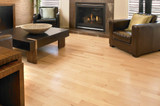1. Solid vs. Engineered Hardwood

Of course we have a whole section on hardwood, but here are the most basic things to know about hardwood flooring, just to get you started. We’ll divide it into two sections because, while both definitely hardwood, these are still very different products.
Globally, engineered hardwood is the most common type of wood flooring used. Solid is preferred in North America, though that trend is definitely shifting. Let’s look at the features of each in more detail.
Solid Hardwood Flooring
- • Is the flooring trend setter, and the most imitated kind of flooring by the synthetic types.
- • Is considered to fit into any design or décor aesthetic.
- • Helps create continuity between rooms to help smaller areas feel more spacious, and maintain continuity between rooms if a home has an open floor plan.
- • Often comes in boards of random lengths, in either planks ranging from 4 to 8 inches in width or strips of only 1 1/2 to 2 1/2 inches wide.
- • The availability of some exotic (not native to the U.S.) species is dependent upon environmental and market conditions. That said, the most popular imports in hardwood are also some of our best selling styles in laminate and vinyl flooring, Brazillian Cherry and African Padauk (also correctly spelled “paduk”).
- • Can be sanded and refinished many times during the life of the floor. This means you can change looks, and do major repairs or overhauls. It’s why this kind of flooring-
- • Can last for up to 100 years.
- • Must be nailed to a subfloor. * This eliminates our ability to put it over concrete.
- • You could pay between five and twelve dollars a square foot for professional installation, especially of unfinished hardwood flooring.
A Solid Hardwood Floor plank is just a board milled from a single piece of timber. 100% of the board comes not only from the same species or tree, but from the same piece of wood off the tree. Historically, solid hardwood was installed for structural purposes, going down at a 90 degree angle to the support beams of the floor for more support and strength.
What it really is: Today solid hardwood flooring is primarily an aesthetic choice, but it is also one of the few floors which can be said to add value to your home. Being a big, thick piece of wood, after a long time of use (say, twenty years) a whole generation of wear and tear can be sanded off, and the floor refinished into, effectively, a brand new floor. You can even do this to change the stain coloring if you overhaul your décor. This cannot be done with engineered hardwood because the layer providing the look of the floor is just the top layer of many layers, therefore too thin to sand. Properly cared for, some solid hardwood floors could last hundreds of years, no kidding.
What you'll get: Solid hardwood comes both pre-finished and unfinished (where the finish would be applied after installation). Solid Boards generally do not exceed 5″ of width or 3/4″ of thickness, and lengths can go up to 8 feet, otherwise the structural integrity of the piece can be compromised. Solid hardwoods often, though not always, come in random lengths, where a box of boards will contain a variety which can range from 1 to 8 feet in length within the same box. It is just a fact of nature that no trees grow with only 6 foot long limbs, so these boards often come in multiple sizes.
Limitations: Solid hardwood is very responsive to the atmosphere. It is more prone to gapping and cupping than other types of flooring, even engineered hardwood. Gapping is the name for a space forming between the planks as the wood contracts. Cupping occurs when the wood expands, and must bend as the boards press against each other. Usually boards cup downward, such that they would hold water in the middle, like a cup. Boards can also crown, bending the opposite way and forming a small hill.
This puts some conditions and restrictions on the uses of solid wood for flooring. It will be subject to expansion and contraction due to humidity and temperature changes, so it should not be used for flooring over radiant floor heating. When installed, solid wood needs a little room to allow for expansion, so it should not be put in snug against them. It is best to install solid hardwood flooring with a staple or nail down method, not glue down, and never floating. This makes installation over concrete impossible for most solid hardwoods. The subfloor must be some form of wood. Solid should never be installed below ground level (called below ‘grade’ in flooring circles) (so, no basements).

Here is a video where our Brian talks about the differences between Solid
&
Engineered Hardwood Flooring.
Engineered Hardwood Flooring
- • Can be nailed down, like solid wood. It can also be glued down (with well tested adhesives), or installed as a floating floor with a cushioning padding underneath.
- • Is more “dimensionally stable”. What’s that? Believe it or not, it’s just what it sounds like – the wood maintains its size dimensions better. Solid wood responds to changes in temperature and humidity by expanding and contracting. Because of how it’s made, Engineered Hardwood does this only to a much, much smaller degree. Some of these even have mixed stone dust with wood fiber in the materials to make the resistance to change reach an extreme level.
- • Is a better choice for moisture prone places like bathrooms and kitchens, and better over radiant heating than solid wood.
- • Can have the look of any solid wood floor, as the top layer is real hardwood.
What it really is: Engineered wood flooring is often made by bonding many criss-crossed layers of wood into one plank of flooring. The top layer, which will be the visible part of the floor, is the species of wood that you want when you select it, substantially the same as the whole of a solid hardwood. The rest of the plank, or its core, will either be made of layers of another species with better strength and stability (poplar is popular), or a medium or high density fiberboard. The layers, anywhere from three to nine of them, will be placed atop each other with the grain directions crossing from layer to layer for strength, and then they will be bonded together. The fiberboard style is even denser, and less responsive to environmental conditions. These manufacturing methods render engineered planks very stable, and extremely resistant to the expansion and contraction issues we can have with solid hardwood.
Extra dimensional stability means that engineered wood floors can not only be installed anywhere you can install a solid floor, they can also go into many places where solid cannot be installed including basements, bathrooms, and any other moisture prone areas. They can go over both wood and concrete subfloors, and can be installed both above and below ‘grade’. For even greater strength and durability there can be acrylic impregnated wood flooring. A liquid acrylic is blended into the product, rendering some woods two to four times as hard as the wood naturally comes, making them especially good in high traffic or commercial places.
And the latest development is actual waterproof hardwood flooring, real, engineered hardwood flooring built on a Stone Plastic Core.

Beveled edges 'outline' the planks
What you'll get: Engineered hardwood floor planks range in thickness from 1/4″ to over a half inch. Engineered wood boards can be both longer and wider than solid hardwood boards. It can come in lengths up to 7 1/2 feet long, which can make installation much easier to do. In addition to full, single planks, engineered flooring can also come in a multi-strip style, where a single plank is made of 2 to 4 pieces along the width for a narrower look with easier installation. Also, engineered woods often come with beveled edges. This means that at the edge of the board, you do not have a 90 degree drop off to the side so that planks fit together snugly, but rather an angled, or even rounded, drop off, emphasizing board separation when installed.
Benefits: An engineered floor can cost less than a solid floor for a couple of reasons. One is that the species of wood only comprises the top layer. An expensive, exotic species of wood will cost less because less of that expensive species is being used to make your product. Additionally, click together style installation systems allow engineered flooring to be placed as a “floating floor”, making for an easier, as well as faster, installation of your floor, lowering the cost and making board replacement easy in the event of a misfortune.
Even if you do not elect to install a floating floor, some engineered flooring can still be installed without requiring a plywood subfloor. The pieces can be nailed directly to the major structural supports of the floor, the thick beams also known as “joists”.
You are more likely to find your engineered flooring pre-finished than unfinished. The finish is a veneer called the “wear layer”, covering the species top layer. The finishes come in a variety of thicknesses, even from the same manufacturers. The advantage of pref-inishing is that in a factory setting many more coats are likely to be applied than would be done in the home after the floor is down. Unfinished floors in the home often only get three coats of finish, while prefinished can go up to 9 coats.
* Alright, yes. There is, just on the market, a brand new adhesive which is
said to work with solid hardwood, and to make it able to be installed on
concrete. Yes. That exists. Two things though. 1) It is prohibitively
expensive. 2) It is brand new, which means that it has not stood the test of
time. Now we’re not slamming this product, and not downplaying it just
because we don’t sell it. This is a kind of serious point, because we are
talking about solid hardwood, the only type of flooring with a potential
longevity of a multiple generations, over 100 years not being unheard of.
It’s a tough hurdle to jump, and if you blow the floor with the adhesive,
you might have just blown the floor altogether, a 100 year floor only
lasting as long as the glue holds up.
– – – –
David is has written and made videos about flooring products and installation since 2011 at Floors To Your Home (.com), where he is also the PPC Manager, a Researcher, a Website & Marketing Strategy Team member, Videographer, Social Strategist, Photographer and all around Resource Jito. In my spare time I shoot and edit video, put together a podcast, explore film history, and mix music (as in ‘play with Beatles multi-tracks’). Connect with
W. David Lichty
Follow Team Floors To Your Home on Facebook

 Brown Tone
Brown Tone
 Unfinished
Unfinished
 Red Tone
Red Tone
 Golden Tone
Golden Tone
 Gray Tone
Gray Tone
 Light Tone
Light Tone
 Medium Tone
Medium Tone
 Dark Tone
Dark Tone
 Brown Tone
Brown Tone
 Red Tone
Red Tone
 Golden Tone
Golden Tone
 Gray Tone
Gray Tone
 Light Tone
Light Tone
 Medium Tone
Medium Tone
 Dark Tone
Dark Tone
 Brown Tone
Brown Tone
 Red Tone
Red Tone
 Golden Tone
Golden Tone
 Gray Tone
Gray Tone
 Light Tone
Light Tone
 Medium Tone
Medium Tone
 Dark Tone
Dark Tone
 Multi Color
Multi Color


